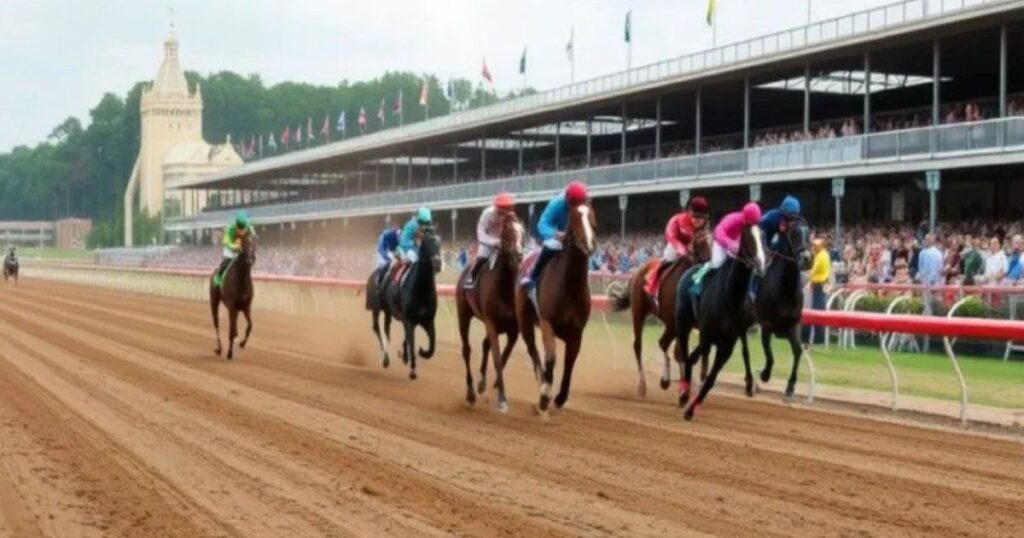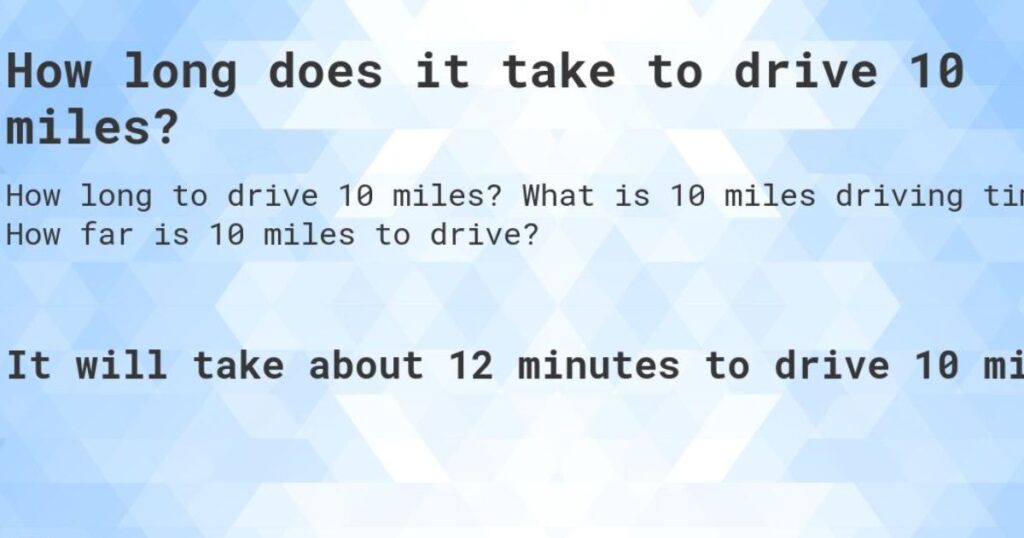Have you ever wondered exactly how far 10 miles stretches? Whether you’re planning a fitness goal, calculating your daily commute, or simply curious about distances, understanding what 10 miles looks like can be challenging without proper context.
Ten miles equals approximately 16.1 kilometers – a distance that takes the average person about 3.5 hours to walk or 45 minutes to cycle at a moderate pace. But these numbers alone don’t create a vivid mental picture of the distance.
In this comprehensive guide, we’ll explore familiar landmarks, sports venues, and everyday scenarios that will help you visualize this significant distance in meaningful ways.
Understanding the 10-Mile Distance: Basic Facts and Figures
Before diving into comparisons, let’s establish some basic facts about the 10-mile distance:
- 10 miles equals 16.1 kilometers
- It contains 52,800 feet
- It measures 17,600 yards
- Walking at average pace (3 mph): Takes approximately 3.5 hours
- Cycling at casual pace (12-14 mph): Takes approximately 45-50 minutes
- Running at recreational pace (6-8 mph): Takes approximately 75-100 minutes
- Driving on highways (65 mph): Takes approximately 9-10 minutes
Understanding these fundamental measures provides a foundation for appreciating the distance comparisons that follow.
Common Objects and Landmarks That Equal 10 Miles

80 Round Trips on a 100-meter Dash Track
A standard 100-meter dash track represents the most fundamental measure in track and field competition. To complete 10 miles on a 100-meter track:
- You would need to make approximately 80 round trips
- This equals 160 one-way dashes
- Professional sprinters rarely complete all repetitions consecutively
- This comparison highlights the immense difference between sprint events and endurance running
The next time you watch Olympic sprinters, consider that their brief explosive effort would need to be repeated 160 times to cover the same distance as a 10-mile run.
20 Times Around an Olympic Velodrome
An Olympic Velodrome track measures 250 meters per lap, with its distinctive banked corners designed for optimal cycling speeds. To reach 10 miles:
- Cyclists would need to complete approximately 20 full circuits
- Professional track cyclists often exceed speeds of 40 mph on these specialized tracks
- The controlled environment of velodromes makes them ideal for understanding exact distances
This comparison is particularly meaningful for cycling enthusiasts who can visualize the repetitive nature of track racing.
160 Football Field Lengths
A regulation NFL football field measures 100 yards (not including end zones), or approximately 91.44 meters. To visualize 10 miles:
- You would need to traverse the length of a football field 160 times
- This distance helps explain why NFL players require such intensive conditioning
- Players may cover several miles during a single professional game
This comparison resonates strongly with American sports fans who can readily picture the standard football field length.
5 Round Trips of Manhattan’s Broadway
Broadway, one of New York City’s most famous streets, runs approximately 2 miles from the southern tip of Manhattan to its northern end. Covering 10 miles would require:
- About 5 complete trips up and down Broadway
- Passing through neighborhoods like the Financial District, Times Square, and the Upper West Side multiple times
- Experiencing the dramatic changes in architecture, culture, and atmosphere along this iconic thoroughfare
This urban measurement provides a familiar reference point for anyone who has visited or lived in New York City.
1.5X Loops on the Central Park Loop
Central Park’s main loop stretches 6.1 miles through the heart of Manhattan, offering a scenic urban running and cycling route. To cover 10 miles:
- You’d need to complete the main loop once and then about half of it again
- The path takes you past iconic landmarks like the Reservoir, Belvedere Castle, and Sheep Meadow
- The varied terrain, including several challenging hills, makes it an excellent gauge for understanding distance in an urban setting
Many New York City Marathon participants use this loop as a key training route, making it a perfect reference point for distance runners.
6X The Golden Gate Bridge
The iconic Golden Gate Bridge spans 1.7 miles across San Francisco Bay, connecting the city to Marin County. To reach 10 miles:
- You would need to make six complete crossings of the bridge
- Each crossing offers dramatic views of the San Francisco skyline, Alcatraz Island, and the Pacific Ocean
- The bridge’s dedicated pedestrian and cycling paths make it an ideal location for distance training
This internationally recognized landmark provides an excellent visual reference for the 10-mile distance.
3 & 1/2 Laps Around Hyde Park
London’s historic Hyde Park features a perimeter path measuring approximately 2.7 miles, encompassing both Hyde Park proper and Kensington Gardens. Reaching 10 miles requires:
- About 3.5 laps around the park’s outer path
- Passing famous landmarks like the Serpentine Gallery, Speaker’s Corner, and the Diana, Princess of Wales Memorial Fountain
- Experiencing the park’s flat terrain and well-maintained paths
This comparison offers a perfect reference for visitors to London or anyone familiar with this historic royal park.
50 Laps Around a Soccer Field
A regulation soccer field measures between 100-130 yards in length, with most professional fields averaging around 110 yards. To visualize 10 miles:
- You’d need to circle the field 50 times
- This helps explain why soccer players can run up to 7 miles during a single professional match
- It illustrates the impressive endurance needed for high-level soccer performance
This comparison is particularly useful for soccer players and fans who can readily picture the dimensions of a standard pitch.
2 & 1/2 Round Trips on the National Mall
The National Mall in Washington, D.C. spans approximately 2 miles from the U.S. Capitol to the Lincoln Memorial. To cover 10 miles:
- You would need to make 2.5 complete round trips
- Each journey takes you past the Smithsonian Museums, the Washington Monument, and numerous war memorials
- The Mall’s straight, level pathways provide an excellent reference for distance
This patriotic measurement helps anyone who has visited the nation’s capital understand the 10-mile distance.
12 Trips Around the Lincoln Memorial Reflecting Pool
The Lincoln Memorial Reflecting Pool stretches 0.42 miles along the National Mall. To reach 10 miles:
- You would need to complete 12 full circuits around the pool
- Each lap offers changing perspectives of the Lincoln Memorial and Washington Monument
- The pool’s perfectly straight edges and level pathways create an excellent reference point
This iconic American landmark provides another Washington, D.C.-based comparison for understanding distance.
92 Laps Around a Hockey Rink
An NHL regulation hockey rink has a perimeter measuring approximately 570 feet, making one complete lap about 0.108 miles. To cover 10 miles:
- You’d need to skate 92 full laps around the rink
- This showcases the impressive stamina of hockey players
- Professional players often incorporate endurance training, though they typically focus on short, explosive bursts
Hockey fans can appreciate this comparison when watching players glide around the ice during games.
7X The High Line in New York City
The High Line, New York’s elevated park built on former railway tracks, runs 1.45 miles from Gansevoort Street to 34th Street. To reach 10 miles:
- You’d need to traverse the High Line’s full length about 7 times
- Each journey offers unique perspectives of the city skyline, public art installations, and gardens
- The linear nature of the High Line creates an interesting way to conceptualize distance
This innovative urban space provides another excellent New York City-based reference point.
40 Laps Around a Standard Running Track
A regulation running track measures precisely 400 meters per lap, with four laps equaling approximately one mile. To reach 10 miles:
- You would need to complete 40 laps
- This distance approaches the length of a full marathon training session
- The controlled environment allows runners to maintain consistent pace and monitor progress
For distance runners and track athletes, this comparison is particularly meaningful and practical.
8X The Kentucky Derby Race
The historic Churchill Downs track, home to the Kentucky Derby, measures exactly 1.25 miles per lap. To visualize 10 miles:
- You’d need to complete eight full circuits of the track
- While Derby horses only run one lap during the famous race that has been held since 1875, this comparison helps imagine the extended distance
- The track’s oval shape provides a standardized way to understand 10 miles
This comparison resonates with horse racing enthusiasts and those familiar with America’s most celebrated equestrian event.
Convert 10 Miles to Other Units
Kilometers, Meters, Feet and Yards
Understanding how 10 miles converts to other common measurements helps provide additional context:
| Unit | Conversion | Explanation |
| Kilometers | 16.0934 kilometers | Standard metric distance measure |
| Meters | 16,093.4 meters | Equivalent to 16+ km |
| Feet | 52,800 feet | Common imperial measurement |
| Yards | 17,600 yards | Useful for sports field comparisons |
These conversions help bridge understanding between different measurement systems and provide additional reference points.
Steps and Movement Metrics
In terms of physical activity measurements:
- Steps: Approximately 20,000-22,000 steps for the average adult
- Calories burned walking: About 800-1,000 calories for a 160-pound person
- Fitness tracker goal: Typically represents 200-220% of daily step goals
“Distance is not just a number; it’s a physical experience that changes depending on your mode of travel, fitness level, and surroundings.”
How Long Does It Take to Travel 10 Miles?

Urban Walking Time
The average person walking in an urban setting would experience:
- 3-3.5 hours at average pace (3 mph)
- 2.5 hours at brisk pace (4 mph)
- 4+ hours if including stops, traffic lights, and rest periods
- Terrain, weather, and personal fitness significantly impact walking time
Walking 10 miles represents a substantial journey on foot that most people would spread across a day rather than attempt in a single session.
Cycling Duration
Cyclists cover this distance at different rates depending on experience level:
- 45-50 minutes for casual cyclists (12-14 mph)
- 30-35 minutes for experienced cyclists (18-20 mph)
- 25 minutes or less for competitive cyclists (24+ mph)
- Wind resistance, terrain, and traffic conditions can significantly alter these times
The 10-mile distance represents a common cycling goal for recreational riders.
Running Benchmarks
For runners, 10 miles presents different challenges based on experience:
- 1:45-2:00 hours for beginners (5-6 mph)
- 1:15-1:30 hours for intermediate runners (7-8 mph)
- Under 60 minutes for advanced runners (10+ mph)
- Elite runners may complete 10 miles in 50-55 minutes
This distance often serves as a critical milestone in marathon training programs.
Driving Duration
In a vehicle, traveling 10 miles typically requires:
- 9-10 minutes on highways with minimal traffic (65-70 mph)
- 15-20 minutes on main roads (35-45 mph)
- 30-60+ minutes in urban areas with traffic congestion
- Weather, road conditions, and time of day dramatically impact driving duration
Many commuters travel approximately this distance each way to work, making it a standard benchmark for daily travel time.
10 Miles in Everyday Life
Daily Commutes
The 10-mile distance represents a significant commuting pattern in the United States:
- The average American commute is 16 miles round trip (8 miles each way)
- 10 miles falls slightly above this average, representing about 25-30 minutes of driving time
- This distance typically balances suburban housing affordability with urban employment access
- Many commuters will travel approximately 2,500 miles annually based on a 10-mile one-way commute
Understanding this distance helps in home selection, transportation planning, and time management.
Delivery Routes
Local delivery routes often organize around 10-mile radius zones:
- Food delivery services typically maintain a 5-10 mile radius for optimal freshness
- Package delivery services often measure efficiency in “stops per mile” within 10-mile zones
- Ride-sharing services calculate pricing tiers partly based on distance bands around 10 miles
- This distance represents a practical boundary for many service-based businesses
The economics of delivery often center around optimizing routes within this practical distance.
Fitness Goals
Ten miles serves as a significant fitness goal for many exercise enthusiasts:
- It represents an advanced walking goal (typically 20,000+ steps)
- For runners, it marks the transition from intermediate to advanced training
- It serves as a common distance for charity events and organized races
- Many marathon training programs feature 10-mile benchmark runs
Fitness trackers often celebrate 10-mile achievements with special badges or recognitions, highlighting the significance of this distance milestone.
Regional Landmarks That Measure 10 Miles
North American Distance Markers
North America offers numerous regional landmarks that help conceptualize 10 miles:
- The Las Vegas Strip plus a return trip (approximately 4.2 miles one-way)
- Crossing the Chesapeake Bay Bridge-Tunnel twice (17.6 miles combined)
- The perimeter of Vancouver’s Stanley Park approximately 5 times
- Chicago’s Lakefront Trail from end to end and halfway back
These landmarks provide regionally specific contexts for understanding the distance.
European Distance References
Europe offers distinct landmarks for measuring 10 miles:
- The distance between Westminster and Greenwich in London, round trip
- Almost exactly the length of Paris’s Boulevard Périphérique (the ring road encircling the city)
- Five complete circumnavigations of Vatican City
- The length of Amsterdam’s central canal ring system, completed twice
These European references provide international context for the distance.
Global Landmarks for Distance Visualization
Worldwide, various landmarks help visualize 10 miles:
- The Great Wall of China’s Badaling section, traversed 2.5 times
- Sydney’s coastal walk from Bondi to Coogee, completed 6 times
- The perimeter of Tokyo’s Imperial Palace grounds, circled 8 times
- The length of Rio de Janeiro’s combined beaches, walked end-to-end
These global references expand our understanding of 10 miles across different cultural contexts.
Visualizing 10 Miles: Interactive Ways to Understand This Distance

Mapping Your Local 10-Mile Radius
Creating personal reference points helps solidify understanding of this distance:
- Draw a 10-mile circle around your home using online mapping tools
- Identify familiar landmarks that fall at approximately this distance
- Plan a 10-mile route through your neighborhood or city
- Recognize how many common destinations fall within this radius
This personalized approach makes the abstract distance concrete and relevant to your daily life.
Using Technology to Visualize 10 Miles
Modern technology offers tools for distance visualization:
- Fitness apps that track and map routes
- Augmented reality programs that overlay distance measurements on real-world views
- Interactive maps that calculate exact distances between points
- GPS-enabled devices that provide real-time distance feedback
These technological solutions help bridge the gap between abstract measurements and tangible experiences.
Final Thoughts
Understanding how far 10 miles stretches becomes much easier when broken down into familiar reference points. Whether visualized as 40 laps around a track, 6 crossings of the Golden Gate Bridge, or the distance covered in a typical suburban commute, these comparisons provide tangible context.
For fitness enthusiasts, 10 miles represents an impressive achievement in endurance training. For urban planners, it defines practical service boundaries and transit zones. For everyday travelers, it constitutes a substantial portion of daily movement.
The next time you encounter a 10-mile distance—whether on a map, in a training plan, or during travel—these practical comparisons will help you better appreciate exactly what that distance entails. Rather than seeing it as an abstract number, you can visualize it through landmarks, activities, and timeframes that make this measurement concrete and meaningful.
Remember that perception of distance changes dramatically based on your mode of transportation, physical condition, and purpose. A 10-mile commute by car might seem negligible, while a 10-mile run represents a significant athletic achievement worth celebrating.
How will you think about 10 miles differently now that you have these reference points?











